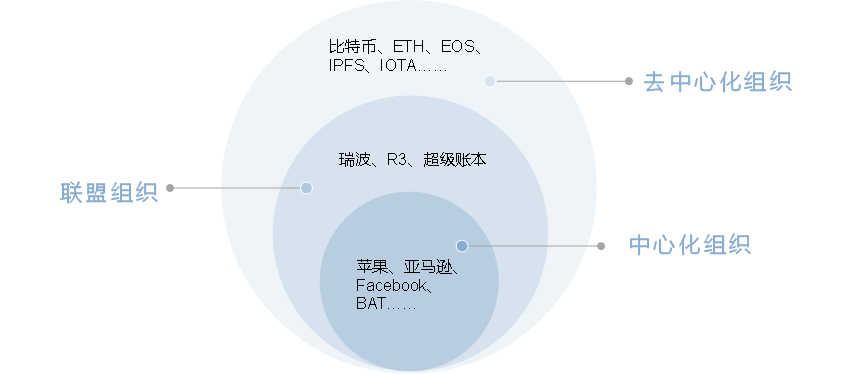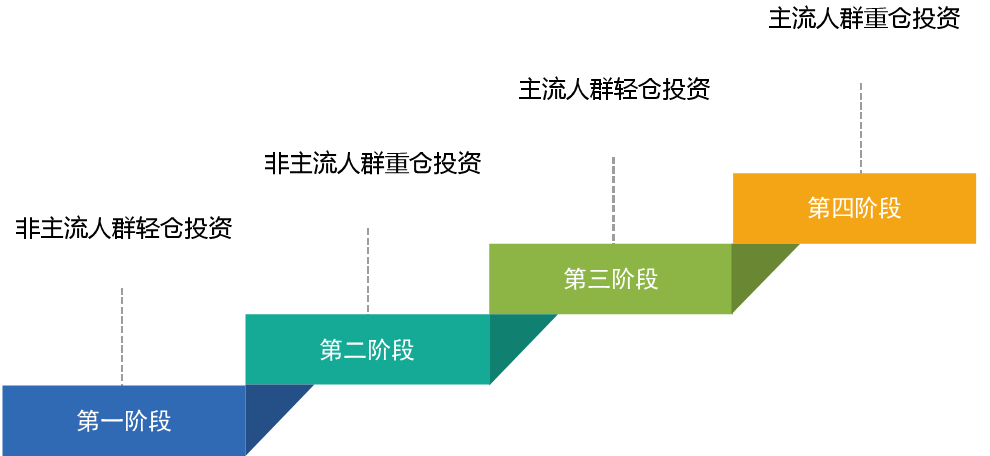Babbitt column 丨 Why does the blockchain wave trigger a new round of business change?
Just like the Internet two decades ago, blockchain is quietly changing our lives. The famous physicist Professor Zhang Shousheng said : Blockchain technology is a new turning point in the Internet world . Since the birth of Bitcoin, blockchain technology has entered the public's perspective, and the Internet era has taken this as a turning point and entered the second half.
From the perspective of history, blockchain has become the general trend, and we will inevitably meet this unprecedented wave.
(1) The "potential" of the blockchain from a development perspective
The following describes the "potential" of the blockchain from three perspectives: information technology, business model, and organizational collaboration:
- In addition to "halving", you need to pay attention to these Bitcoin technologies in 2020
- Bitcoin welcomes new technology update, Core developers teach you how to verify the client
- Bitcoin's Secret History: Why is CSW being mocked by the group?
① Law of Information Technology Development
The development of information technology is a repetitive process of constantly establishing and breaking monopolies.
Today, Google, Amazon, and Facebook, as well as domestic Baidu, Ali, and Tencent occupy the absolute giant status with the help of the Internet. They have invested in mergers, acquisitions, and vertical and horizontal alliances, constantly eroding potential competitors, and constantly consolidating and expanding their business ecology. They are getting stronger and stronger, invincible and omnipotent.
However, from a philosophical perspective, there is no eternal hegemon. So who are their disruptors?
Only from the perspective of history, can we see the future trend. In one of his articles, Monegro described the history of the information technology industry over the past 80 years. In the text, this history is called a cyclical history of expanding, consolidating, and breaking down centralized authority. In essence, this history is a repeated process of constantly establishing and breaking monopolies.
Some forward-looking companies have quickly established their monopoly position with the development of new technologies, and then they are broken by the latecomers in the next wave of technological revolution. At the same time, emerging disruptors have become new monopolies. This process repeats itself.

Figure 1 Stages of Information Technology Development
As shown in Figure 1.1 above, the history of information technology development is roughly divided into four stages:
a. The first era of information technology was the hardware era of the 1950s and 1960s, represented by IBM.
The birth of the transistor made information technology an industry. Its appearance greatly reduced the cost of early computers. In the process, with the standardization of transistors, IBM quickly established a computer business in the 1950s and 1960s and quickly monopolized the market to become the world's largest computer company.
b. The second era of information technology is the software era of the 70s and 80s, represented by Microsoft Corporation.
With the rapid development and popularity of personal PCs, the demand for software applications has rapidly increased. With its absolute advantage of occupying 80% of the operating system market share, Microsoft has achieved high profits. In a sense, Microsoft is the equivalent of the PC software industry itself. At this stage, IBM's influence weakened and Microsoft became the new hegemon.
c. The third era of information technology is the Internet era of the 90s and 00s, represented by Google.
With TCP / IP becoming the Internet protocol standard, information technology has entered the Internet era. In 1991, Tim Berners-Lee announced the birth of WWW to the public, and the commercialization of the Internet began.
Although the Internet bubble burst in 2000, most .com companies disappeared. But after the bubble, the best Internet companies were left, such as Google, Amazon, Facebook, and so on. Then, in the decade of 2000-2010, the number of Internet users increased from 400 million to over 2 billion, covering 30% of the world's population. At the same time, in China and abroad, giants dominate the world in three dimensions: search, e-commerce, and design.
Currently, we are in the era of centralized integration by BAT and giants such as Google, Apple, Facebook and Amazon. They use their massive data advantage to abduct users and suppress and interfere with startups. The risks and disadvantages of centralization have gradually emerged, and the contradictions between users and Internet giants have become increasingly prominent.
d. The fourth era of information technology is the era of blockchain since the 10's.
Despite repeated prosperity and bubbles, the blockchain has shown its robust vitality. We boldly predict that from 2020, the blockchain industry will enter a truly benign development cycle. Blockchain solves the problem of value transmission and trust that cannot be solved by the Internet. The token on the blockchain can promote large-scale and efficient collaboration, so it can fundamentally change the current business paradigm.
To sum up, blockchain plays a very good role as a disruptor to break the monopoly of Internet giants, genetically changes and reforms business models, and will lead a new era of information technology in the near future.
② Business model of mainstream companies
As shown in Figure 2, the transformation of mainstream companies' business models is roughly divided into four stages. On the whole, the business trajectory of the world's giant companies has changed from being non-centralized to centralized, and then from centralized to decentralized.

Figure 2 Evolution of business models of mainstream companies
Before 2010, the leading companies in the market were those that provided a single product and service, such as Nokia and Sony. In this era, each enterprise has its own politics and is in a state of no center.
After 2010, Apple built iTunes and App Store, and platform companies have become mainstream (Domestic platform companies are typical of Alibaba). They provide a communication channel for both the sales and purchase sides, linking buyers and sellers, and solving the problem of information asymmetry. In this era, a centralized platform is formed and has a considerable right of speech.
In 2015, the rise of the sharing economy, the rapid development of C2C organizations such as Uber, AirBnB, Didi Taxi, and set off another wave of Internet economy. They make C and C multi-directional, and produce exponential value. In this era, the centralized platform's restrictions on users are relatively weak, and users are encouraged to freely have relationships under the same rules.
After 2020, the infrastructure in the ecosystem is completed by the blockchain, and all rules and trust are based on code. Users operate in the ecology based on the rules that cannot be tampered with, the organizational boundaries are further enlarged, the network effect is enhanced, and the benefits and rights obtained by each ecological user become more.
Figure 3 below shows the category change of global giants between 2008 and 2018. It can be seen from the figure that the number of platform companies has increased sharply in 2018.

Figure 3 Changes in the category of giant companies
This shows that the entire business ecological model will tend to be decentralized. Of course, decentralization is the ideal state of the future. Therefore, we predict that the following three business ecological models will coexist in the next 5-10 years, as shown in Figure 4:
a. Centralized Giant
The giants still have a lot of influence and will not die out immediately. Just as in the era of Microsoft's domination, IBM is still very strong. With the development of the blockchain, the influence of the giants will gradually weaken, but for a long time, it is still the main body of the business model.
b. Alliance chain
Blockchain networks developed by or serving an industry alliance, such as R3 and Ripple.
c. Decentralized ecology
Various DApp applications based on the public chain. In the future, DApps in some areas will gradually replace App, which is well known and used by users.

Figure 4 Future business ecological model
③Human society collaboration
The history of human-social collaboration is a history from division to integration. Human social collaboration is changing from decentralized to centralized, and it is bound to change to decentralized after being highly concentrated. See Figure 5.

Figure 5 Evolution of human collaboration
The earliest way of cooperation in human society was hunting at the beginning of human society. Primitives complete hunting activities by collaborating in groups of three or five or to complete the tribe, sharing prey together. This kind of collaboration is simple and decentralized, in a sense it is a decentralized way of collaboration.
With the development of productive forces, humans have entered the era of manual workshops. The collaborative method of the hand workshop has a prototype of centralization. From this point on, the collaborative way of human society began to evolve like a centralization.
Following the emergence of the company, the popularity of the assembly line, and the collaboration of human society began to become highly centralized.
Immediately after, the emergence and widespread application of the Internet improved the efficiency of communication and coordination, and greatly accelerated the further centralization of collaboration methods. The emergence of foreign Internet giants such as Google, Facebook, Amazon, and domestic BAT is the result of a highly centralized approach to collaboration.
The author predicts that with the continued development of the Internet, the Internet giants will become more centralized, and the three dimensions of search, social and e-commerce giants will merge into one. In the future, the giants that dominate the rivers and lakes will emerge.
Centralized collaboration has greatly improved efficiency, and is a very effective way of collaboration when the level of productivity is not high. In the future, productivity will be highly developed, advanced technologies such as the Internet of Things and artificial intelligence will mature, and people's demand for trust and fairness will become more prominent. By that time, the decentralized collaboration ecology of the underlying facilities based on blockchain technology will become the main form of commerce in the future, and decentralized collaboration will become the main form of collaboration in human society.
(2) Blockchain has the characteristics of "potential"
The above clarifies the necessity of blockchain as the "potential" of the future from a development perspective. Next, let's see if the blockchain has the characteristics of "potential".

Figure 6 "Position" and "Subversion"
What is potential, potential is the future. What is the future? What can subvert the present is the future. What is subversion? The following two conditions must be met:
① Subversion must be deeply disgusted by mainstream people
Those technologies and concepts that can be easily understood and accepted are not subversive and destructive! The real subversion must start with skepticism, instinctual rejection, and even deep hatred!
Bitcoin has been opposed by many prominent personalities since its birth. Warren Buffett, who is worshipped by the world, is skeptical of Bitcoin. He believes that "Bitcoin is a bubble"; the famous Professor Lang rejected Bitcoin instinct. He once said on a TV show that "you send me Bitcoin "I wouldn't want"; there is also a celebrity from the media who hates bitcoin. He yelled at "bitters" in a short video he recorded.
From this point of view, Bitcoin and its underlying technology blockchain have the characteristics of "subversion".
② Subversion must conflict with the vested interests of the giants
To subvert the giants, you must genetically exclude them. If the gene is the same as the giant, the business model is the same, and the market is the same. So, sooner or later, it will be destroyed by the giants, or acquired.

Figure 7 Kodak camera
Kodak, once a giant in the film industry, was also the first inventor of digital camera technology. Kodak chose to cover up this technology because it is difficult to abandon the huge benefits of the traditional film market. This deadly decision error led to its elimination in the digital age. Kodak was right at the time, and no one would be willing to abandon huge vested interests. However, because of reluctance, the giants watched as they did not subvert, but they were helpless.
Before the advent of the blockchain, a problem has been troubling people: Internet giants such as BAT have subverted traditional giants such as Microsoft Nokia, so who will subvert BAT?
At one time, people had some speculation that they believed that the disruptors would be 360, Xiaomi, JD.com, or some other rising star such as Momo and Today's Headline. True, these dark horse companies are extremely disruptive and vital. However, after careful analysis, it is not difficult to find that there are giants behind these companies. Due to genetic consistency, BAT or the capital behind it continuously strengthens its ecology through mergers and acquisitions and other means. In this way, the stronger are stronger.
The advent of blockchain has made it possible for the giants to be subverted. Blockchain is a heterogeneous one, and its decentralized genes and the centralized genes of the Internet giants are extremely exclusive and incompatible. Once the giants open their databases and let the centralized data be distributed and stored, they will lose control of the data, that is, huge profits. Therefore, the giants cannot do this, and the capital behind the giants does not allow them to do so.
From the above analysis, it can be seen that the blockchain has the characteristics of "potential".
(3) Development stage of blockchain
The development of the blockchain is divided into four major stages, as shown in Figure 8 below. They are:
① Light warehouse investment by non-mainstream people
Non-mainstream people refer to those who do not have the main wealth of the society, such as geeks, middle and lower classes, such as the legendary roast cat of the currency circle, big empty wings, and foreign "pizza brothers". This stage is an early stage of the budding industry, and these non-mainstream people make tentative investments.
② Heavy storage investment by non-mainstream people
When non-mainstream people realize that Bitcoin and blockchain will be a major trend, or they are convinced that it will bring high returns. At this stage, non-mainstream people began to enter the warehouse. For example, the celebrity in the currency circle "Bao Erye" invested all their net worth in Bitcoin and mining farms. The people entering this stage will be those who seize the opportunity and enjoy the industry's largest dividends.
③ Light warehouse investment by mainstream people
The mainstream crowd refers to traditional industry elites, such as high-net-worth individuals such as real estate and hotel industry executives, coal bosses, and large corporate executives. At this stage, this group of people has invested a small proportion of wealth in tentative investments, such as Li Jiacheng investing 100 million in bitcoin to pay for companies. It is worth noting that the light warehouse investment of the mainstream population is much larger than the heavy warehouse investment of the non-mainstream population. At this stage, the increase in admission funds will be exponential.
④ Heavy warehouse investment by mainstream people
In the fourth stage, mainstream people began to recognize the arrival of the trend and decided to make a decisive position. At this time, it is difficult for non-mainstream people to have investment opportunities.
After this stage, that is, when the mainstream crowd entered the game, a large base of non-mainstream masses began to wake up and follow up, becoming the industry's last wave of receivers. At this point, the industry dividend period has ended and investment opportunities are no longer there.

Figure 8 Development stages of the blockchain
Judging from the current industry situation, the second phase of the development of blockchain is basically over, and it is about to enter the third phase, that is, the stage of light warehouse investment by mainstream people. At present, the blockchain continues to receive the attention of the mainstream society, and some traditional business owners have shown strong interest in the blockchain industry. This indicates that the mainstream population is about to enter the market, and the blockchain industry is entering a new starting point for a full-scale outbreak.
In summary, the blockchain wave has inevitably arrived, and it is unstoppable. We should actively embrace new technologies and explore the impact and changes of new technologies on traditional business forms, so as not to be swallowed up by the wave of business changes triggered by the technological revolution.
We will continue to update Blocking; if you have any questions or suggestions, please contact us!
Was this article helpful?
93 out of 132 found this helpful
Related articles
- The two founders talk about Ethereum: expansion is the number one priority, and more enterprises will use Ethereum in the future
- The company system enters the dusk token economy and the future is expected
- Agricultural blockchain company GrainChain secures $ 8.2 million in Series A funding, and Overstock provides $ 5 million in support
- Babbitt Column Deng Jianpeng: Lessons from the FCoin Thunderstorm on the Exchange
- Ethereum is up 5% in the day, and all the outbreaks have already erupted. It is time to take the next step.
- Webster Ratings: Ethereum is the hot spot and it will lead the industry
- Aviation giant Honeywell will use blockchain platform GoDirect Trade to track aviation parts, and Boeing has provided $ 1 billion in parts support






